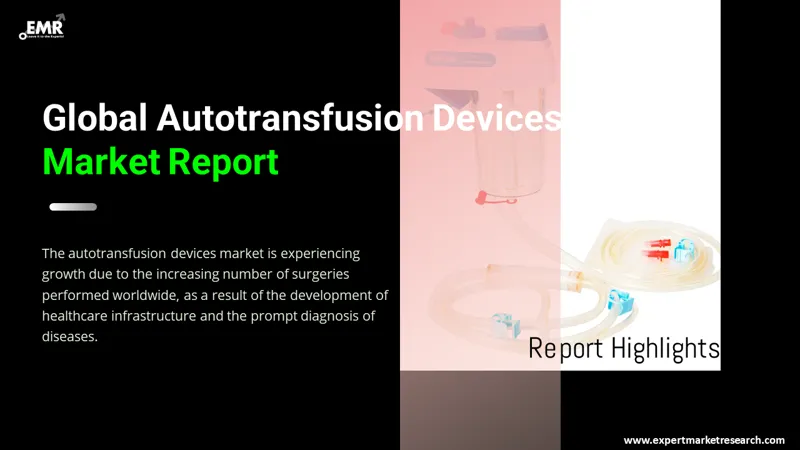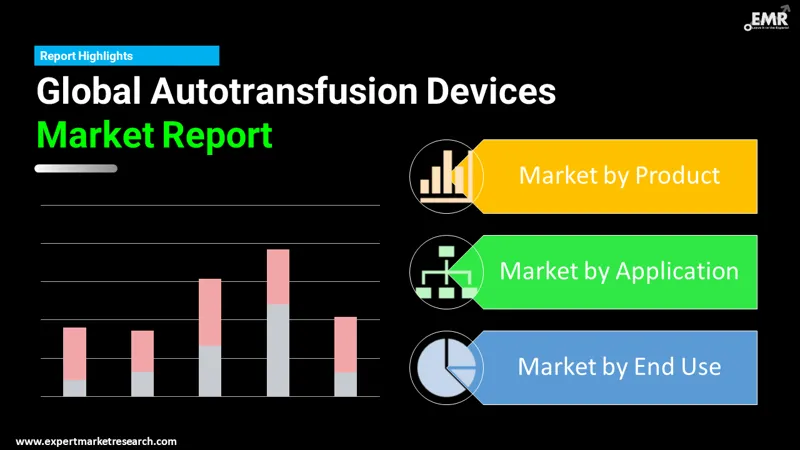
Consumer Insights
Uncover trends and behaviors shaping consumer choices today
Procurement Insights
Optimize your sourcing strategy with key market data
Industry Stats
Stay ahead with the latest trends and market analysis.
The global autotransfusion devices market size attained a value of USD 312.12 Million in 2025, driven by developing healthcare infrastructure, rapid diagnosis of diseases, rising incidences of haemorrhage, increasing need for safe and sufficient medical procedures, availability of different types of autotransfusion systems and their exceptional benefits. The market is anticipated to grow at a CAGR of 5.00% during the forecast period of 2026-2035 to attain a value of USD 508.41 Million by 2035.
Base Year
Historical Period
Forecast Period
Compound Annual Growth Rate
5%
Value in USD Million
2026-2035
*this image is indicative*
Based on product type, the demand for intraoperative transfusion systems is witnessing a healthy growth. The intraoperative autotransfusion systems enable the collection of a patient's own blood during a surgery or an invasive procedure where the blood loss can be anticipated or unpredictable. The washed red blood cells are then transfused back to the patient’s body after the removal of discarded products like platelets and anticoagulants. It decreases net perioperative blood loss, helps maintain postoperative haemoglobin, reduces the risk of blood-borne diseases, reduces patient care costs, eliminates the risk of receiving wrong blood due to human or clerical error, and helps recycle lost blood products. Moreover, the patient's own fresh red blood cells are known to maintain their flexibility in the microcirculation, thereby becoming immediately active in tissue oxygenation. The government initiatives towards developing national frameworks that would maximise patient safety during intraoperative autotransfusion are likely to bolster the autotransfusion devices market growth over the forecast period.

Read more about this report - REQUEST FREE SAMPLE COPY IN PDF
Autotransfusion devices refer to equipment that helps in the autotransfusion of blood, including the offering of autologous blood to a patient during surgical or invasive procedures. The autologous blood is collected from a patient during heavy blood loss, and the washed red blood cells are re-infused into the body. The autotransfusion of blood is safe, cost-effective, and reduces the dependency on allogenic blood.
Breakup by Product Type
Breakup by Application
Breakup by End User
Breakup by Region

Read more about this report - REQUEST FREE SAMPLE COPY IN PDF
The increasing number of surgeries conducted worldwide, owing to the developing healthcare infrastructure and the rapid diagnosis of diseases, leads to the increased demand for blood for performing these procedures, which is driving the autotransfusion devices market growth. The rising incidences of haemorrhage and the increasing need for safe and sufficient blood and blood products to save lives are propelling the demand for these devices. The autotransfusion of blood offers multiple advantages over donated blood, such as it is cost-effective, does not lose its fluidity and function during storage, reduces the risk of infections and complications, eliminates the dependency on blood bank reserves, and reduces morbidity rate. Additionally, it is considered a safe procedure, owing to the advancements in filtration and sterile techniques. The availability of different types of autotransfusion systems, such as in-line, self-filling, and continuous, is aiding the market development. Continuous autotransfusion is faster, requires less staffing involvement, and poses a reduced risk of contamination. The strong presence of autotransfusion device manufacturers and their initiatives to launch sophisticated, effective, and automated devices are expected to augment the market growth over the forecast period.
The report gives a detailed analysis of the following key players in the global autotransfusion devices market, covering their competitive landscape, capacity, and latest developments like mergers, acquisitions, and investments, expansions of capacity, and plant turnarounds:
The comprehensive EMR report provides an in-depth assessment of the market based on the Porter's five forces model along with giving a SWOT analysis.




*While we strive to always give you current and accurate information, the numbers depicted on the website are indicative and may differ from the actual numbers in the main report. At Expert Market Research, we aim to bring you the latest insights and trends in the market. Using our analyses and forecasts, stakeholders can understand the market dynamics, navigate challenges, and capitalize on opportunities to make data-driven strategic decisions.*
Get in touch with us for a customized solution tailored to your unique requirements and save upto 35%!
In 2025, the global market Autotransfusion Devices attained a value of USD 312.12 Million.
The market is anticipated to grow at a CAGR of 5.00% during the forecast period of 2026-2035 to reach a value of USD 508.41 Million by 2035.
The major market drivers include the developing healthcare infrastructure, rapid diagnosis of diseases, rising incidences of haemorrhage, increasing need for safe and sufficient medical procedures, availability of different types of autotransfusion systems and their exceptional benefits, need to reduce the dependency on blood bank reserves, and government initiatives to maximise patient safety during intraoperative autotransfusion of blood.
The key trends guiding the growth of the market include the rising number of surgeries worldwide, development of efficient and automated autotransfusion devices, and the increasing penetration of market players in emerging nations.
The major regions are North America, Europe, the Asia Pacific, Latin America, and the Middle East and Africa.
The significant product types of autotransfusion devices include autotransfusion systems, and consumables and accessories.
The different applications of autotransfusion devices include cardiovascular surgeries, orthopaedic surgeries, neurological surgeries, and obstetrics and gynaecology surgeries, among others.
The major end uses of autotransfusion devices include hospitals, and speciality clinics, among others.
The major players in the market are LivaNova PLC, Haemonetics Corporation, Medtronic plc, Fresenius SE & Co. KGaA, and Becton, Dickinson, and Company (BD), among others.
Explore our key highlights of the report and gain a concise overview of key findings, trends, and actionable insights that will empower your strategic decisions.
| REPORT FEATURES | DETAILS |
| Base Year | 2025 |
| Historical Period | 2019-2025 |
| Forecast Period | 2026-2035 |
| Scope of the Report |
Historical and Forecast Trends, Industry Drivers and Constraints, Historical and Forecast Market Analysis by Segment:
|
| Breakup by Product Type |
|
| Breakup by Application |
|
| Breakup by End User |
|
| Breakup by Region |
|
| Market Dynamics |
|
| Supplier Landscape |
|
| Companies Covered |
|
Single User License
One User
USD 5,499
USD 4,949
tax inclusive*
Datasheet
One User
USD 3,299
USD 2,969
tax inclusive*
Five User License
Five User
USD 6,999
USD 5,949
tax inclusive*
Corporate License
Unlimited Users
USD 8,199
USD 6,969
tax inclusive*
*Please note that the prices mentioned below are starting prices for each bundle type. Kindly contact our team for further details.*
Flash Bundle
Small Business Bundle
Growth Bundle
Enterprise Bundle
*Please note that the prices mentioned below are starting prices for each bundle type. Kindly contact our team for further details.*
Flash Bundle
Number of Reports: 3
20%
tax inclusive*
Small Business Bundle
Number of Reports: 5
25%
tax inclusive*
Growth Bundle
Number of Reports: 8
30%
tax inclusive*
Enterprise Bundle
Number of Reports: 10
35%
tax inclusive*
How To Order

Select License Type
Choose the right license for your needs and access rights.

Click on ‘Buy Now’
Add the report to your cart with one click and proceed to register.

Select Mode of Payment
Choose a payment option for a secure checkout. You will be redirected accordingly.
Gain insights to stay ahead and seize opportunities.

Get insights & trends for a competitive edge.

Track prices with detailed trend reports.

Analyse trade data for supply chain insights.

Leverage cost reports for smart savings

Enhance supply chain with partnerships.

Connect For More Information
Our expert team of analysts will offer full support and resolve any queries regarding the report, before and after the purchase.
Our expert team of analysts will offer full support and resolve any queries regarding the report, before and after the purchase.
We employ meticulous research methods, blending advanced analytics and expert insights to deliver accurate, actionable industry intelligence, staying ahead of competitors.
Our skilled analysts offer unparalleled competitive advantage with detailed insights on current and emerging markets, ensuring your strategic edge.
We offer an in-depth yet simplified presentation of industry insights and analysis to meet your specific requirements effectively.
Share